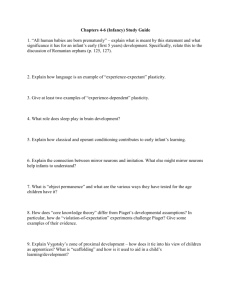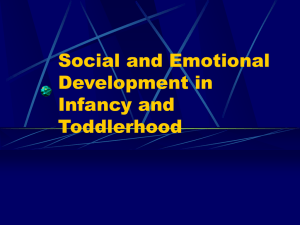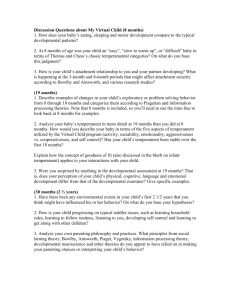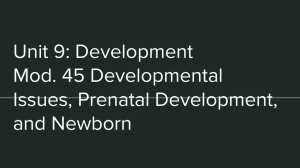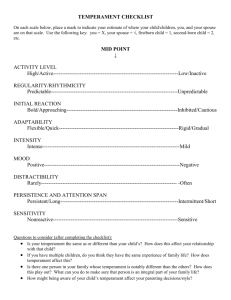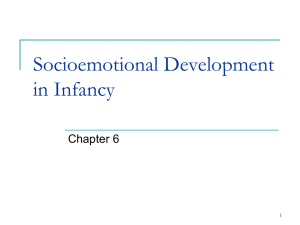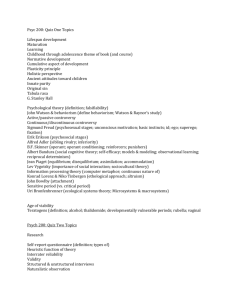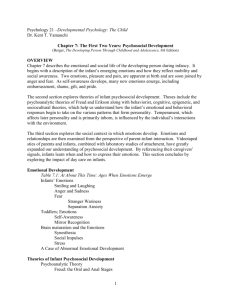Berk Chapter 6: Cognitive Development in Infancy and Toddlerhood
advertisement
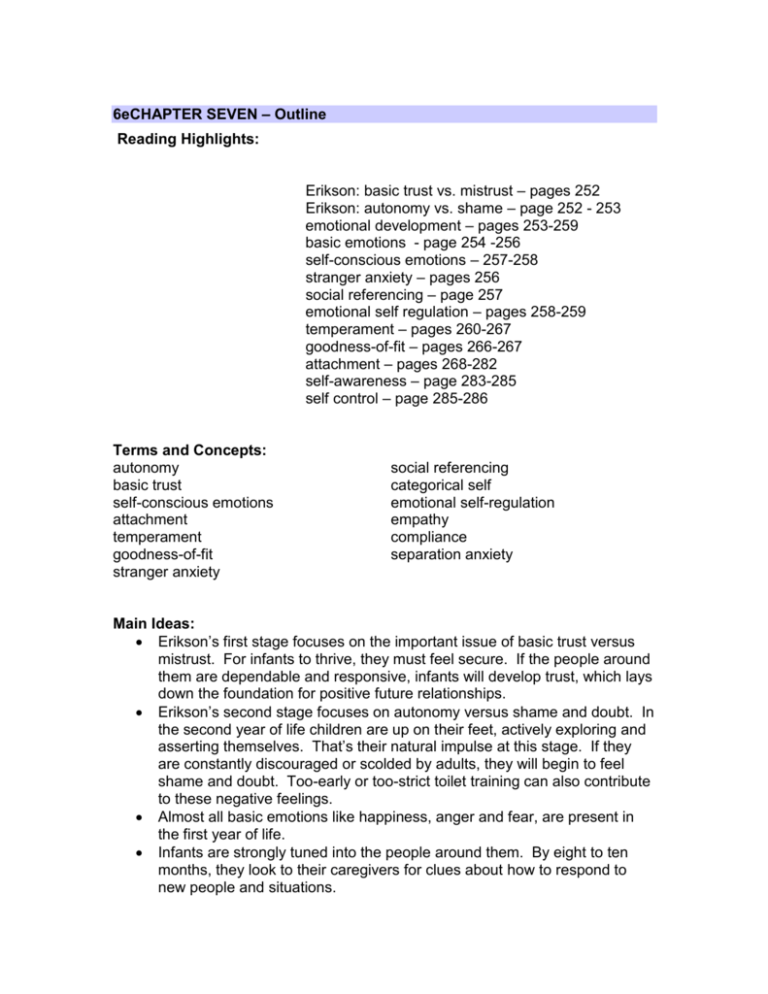
6eCHAPTER SEVEN – Outline Reading Highlights: Erikson: basic trust vs. mistrust – pages 252 Erikson: autonomy vs. shame – page 252 - 253 emotional development – pages 253-259 basic emotions - page 254 -256 self-conscious emotions – 257-258 stranger anxiety – pages 256 social referencing – page 257 emotional self regulation – pages 258-259 temperament – pages 260-267 goodness-of-fit – pages 266-267 attachment – pages 268-282 self-awareness – page 283-285 self control – page 285-286 Terms and Concepts: autonomy basic trust self-conscious emotions attachment temperament goodness-of-fit stranger anxiety social referencing categorical self emotional self-regulation empathy compliance separation anxiety Main Ideas: Erikson’s first stage focuses on the important issue of basic trust versus mistrust. For infants to thrive, they must feel secure. If the people around them are dependable and responsive, infants will develop trust, which lays down the foundation for positive future relationships. Erikson’s second stage focuses on autonomy versus shame and doubt. In the second year of life children are up on their feet, actively exploring and asserting themselves. That’s their natural impulse at this stage. If they are constantly discouraged or scolded by adults, they will begin to feel shame and doubt. Too-early or too-strict toilet training can also contribute to these negative feelings. Almost all basic emotions like happiness, anger and fear, are present in the first year of life. Infants are strongly tuned into the people around them. By eight to ten months, they look to their caregivers for clues about how to respond to new people and situations. Emotional self-regulation – our ability to soothe or entertain ourselves – also begins in infancy. Adults can support this development for the infants in their care. Infants vary in temperament, which is the measure of how active, attentive, intense or fearful their personalities are. Temperament is determined by both biology and environment. When parents understand their children’s shy or active or difficult temperament, they can adjust their caregiving style to fit. Infants must connect emotionally to their caregivers in order to be healthy and to thrive. Infants who are deprived of this vital attachment can have serious lifelong emotional and social problems. A major task for infants is to develop a sense of themselves as separate from the world around them. This happens gradually; the growing sense of self causes an increasing awareness of others and toddlers begin to show empathy and peer sociability. Reading Content: Erikson Basic trust vs. mistrust autonomy vs. shame and doubt Emotional Development happiness / social smiling / laughing sadness, fear and anger stranger anxiety social referencing Self-conscious Emotions Emotional Self-regulation Temperament easy / difficult / slow to warm up shyness stability of temperament genetic and environmental influences goodness-of-fit Attachment Bowlby’s Ethological theory separation anxiety cultural variations multiple attachments child care and secure attachment peer sociability Self Understanding self-awareness empathy self control and compliance Practice Quiz 7 6e 1. Three types of temperament are: a. easy, difficult, slow to warm up b. easy , difficult, intense c. shy, intense, easy d. difficult, shy, positive 2. What percentage of children show unique blends of temperament characteristics, rather than falling clearly into one category? a. 50% b. 12% c. 25% d. 35% 3. Jasmine seems to be particularly sensitive to external stimuli like light, heat and touch. She has trouble making transitions, and does not adapt easily to new situations. How might her temperament be characterized? a. easy b. difficult c. slow to warm up d. can’t tell from these items 4. Corinne has recently started to walk. When she falls down, she looks at her caregiver for a response. When her caregiver says cheerfully “Ups-a-daisy!”, Corinne gets up and takes a few more steps. This is an example: a. separation anxiety b. secure attachment c. social referencing d. self-conscious emotions 5. An 8-month-old child is more likely than a 3-month-old to a. smile when interacting with people b. remain calm and unperturbed when encountering a stranger c. remain cheerful when mom leaves d. show anger when a favorite toy is taken away 6. Which of the following situations might cause an 18-month-old child to experience one of the self-conscious emotions? a. being fed when she feels hungry b. being buckled into the car seat c. being scolded for taking another child’s toy d. being put in a play situation with a new child 7. The appearance of the self-conscious emotions are tied to the development of a. a sense of self b. a sense of shame c. emotional self-regulation d. temperament 8. When 2 year old Brandon finishes his juice, he says “I good boy!”. This is an example of a. empathy b. social referencing c. temperament d. categorical self 9. Around 18 months, the beginnings of self-control appear in the form of a. benevolence b. realism c. compliance d. reciprocity 10. When the caregiver’s expectations and responses are in tune with the child’s temperamental needs, this is called a. goodness of fit b. social referencing c. attachment d. compliance Child Growth and Development Video Worksheet (Berk Chapter 7) EMOTIONAL / SOCIAL DEVELOPMENT : BIRTH – 2 ½ I. ERIK ERIKSON described development through the lifespan in 8 stages; each stage had a psychosocial crisis or issue to be overcome STAGE 1: Basic trust versus mistrust (birth to one year) Major task of this stage: infants gain trust or confidence that the world is a good place How achieved: Warm responsive care helps infants establish a secure base STAGE 2: Autonomy versus shame and doubt (1 – 3 years) Major task of this stage: new mental and motor skills and a developing sense of self cause older infants and toddlers to want more control over their bodies and their lives How achieved: Parents who allow reasonable choice and do not shame or criticize young children’s efforts help their children build a positive sense of autonomy (self-governance) II. TEMPERAMENT Defined as: early appearing stable individual patterns of emotional responsiveness to the environment. Heredity and genetics are both factors in temperament. Culture is influential in deciding how temperamental characteristics are interpreted. (Example: a child who is labeled very shy in one culture may be thought to be quiet and well-behaved in another.) Some traits that define temperament: quality and intensity of emotional reaction, activity level, attention, distractability, approach/ withdrawal (to new situations, people or other stimuli) 3 Temperament Categories or types (Thomas and Chess, 1956): 1. easy 40% 2. difficult [challenging] 10% 3. slow to warm up 15% (Other 35% of people are a blend of temperamental characteristics) How long does temperament type last? May last a lifetime, but usually changes as individual matures; however, change in temperament is rarely extreme. We might say temperament modifies. How can it change? Maturation and child rearing practices are both factors in modification of temperament. Patient and supportive parenting (“goodness of fit”) helps child better manage his/her response to stimuli. III. ATTACHMENT Defined as: strong affectionate tie between child and significant people in her/ his life How do parents contribute to attachment? Sensitive caregiving, caregiver responsiveness, warm physical contact are important elements in developing attachment Child behaviors that indicate secure attachment: 1. 2. 3. Anchoring = child does not go beyond a certain safe distance to caregiver Refueling = child returns to caregiver’s side periodically for reassurance IV. SOCIAL RESPONSES Smiling: At 2 weeks: At 3 –6 weeks: At 4 –6 months: At 6 -7 months: This new development results in ____________________ _________________. Towards end of first year, child may also develop ________________ _________________, which results when: This lasts until about age:__________________________. V. SELF-AWARENESS Develops when:____________________________________ Some behaviors that indicate development of self awareness: Child may show an increase in negativity, which is: On the positive side, the child may also begin to show ___________________, which is: VI. DEVELOPMENT OF STANDARDS Beginning of an understanding of _________________ and _________________. Child understands that some things are unacceptable, such as : When child is unable to meet a standard she/he may feel__________________________ When child is able to meet a standard, she/he feels______________________________. Berk Chapter 7: Emotional and Social Development in Infancy and Toddlerhood 6e Erikson’s Theory Erikson’s First Stage = ___________ vs. __________________ Age:______________ In this stage, the child needs ________________________________________________ in order to ______________________________________________________________. Erikson’s Second Stage = ________________ vs. ____________ and _______________ Age: ________________ In this stage, the child needs ___________________________ _______________________________________________________________, in order to_____________________________________________________________________. Emotional Development Name any 4 basic emotions: ________________________, _______________________,___________________,________________________, Social smiling appears at age: _____________ Laughing begins:__________________ Fear begins: ______________________ Briefly explain the difference between the newborn’s smile, and social smiling: ________________________________________________________________________ ________________________________________________________________________ Explain in your own words why the infant’s angry reactions increase with her/ his age: ________________________________________________________________________ ________________________________________________________________________ ________________________________________________________________________ Define stranger anxiety: ________________________________________________________________________ Define social referencing: ________________________________________________________________________ ________________________________________________________________________ Why are emotions like shame, pride, embarrassment and guilt called “self-conscious emotions”?______________________________________________________________ ________________________________________________________________________ When a baby who has been over stimulated by noisy interaction with family members turns and looks away from everyone, or crawls away, she is showing signs of _________________________ __________- __________________________. How do caregivers help infants regulate their emotional states? _______________________________________________________________ _______________________________________________________________ How do social expectations influence emotional expression, and reinforce gender differences?_______________________________________________________ _________________________________________________________________ _________________________________________________________________ Temperament Define temperament:__________________________________________________ ____________________________________________________________________ Thomas and Chess profiled 3 temperament types: 1. the __________________ child = 40% 2. the __________________ child = 10% 3. the __________________ child = 15 % List 4 dimensions that researchers look at in analyzing temperament type: _______________________________ _________________________________ _______________________________ _________________________________ What factors influence the stability of temperament in the early years? _______________________________________________________________________ _______________________________________________________________________ _______________________________________________________________________ _______________________________________________________________________ Nature vs. Nurture: if someone stated that shyness was all caused by the way children were raised, what would you tell them about the temperament research of Jerome Kagan? ________________________________________________________________________ ________________________________________________________________________ ________________________________________________________________________ ________________________________________________________________________ ________________________________________________________________________ Contrast how the child-rearing beliefs of Japanese versus American mothers affect their children’s development: ________________________________________________________________________ ________________________________________________________________________ ________________________________________________________________________ ________________________________________________________________________ Define goodness of fit in your own words: ________________________________________________________________________ ________________________________________________________________________ Define attachment: ________________________________________________________________________ ________________________________________________________________________ Earlier theories held that feeding was the central mode for developing attachment between infant and caregiver. How does the experiment with the baby monkeys contradict this belief? ________________________________________________________________________ ________________________________________________________________________ ________________________________________________________________________ ________________________________________________________________________ ________________________________________________________________________ Define separation anxiety: ________________________________________________________________________ According to Bowlby’s theory, when a child has moved through the four phases of attachment development, the child has then constructed an ______________ _________________ ____________, which will serve as a guide for all future close relationships. Give an example of a situation in which infants lack the opportunity to develop early attachments:______________________________________________________. In these cases, it ahs been discovered that children can develop fist attachment bonds a late as _______________ years of age. However they are likely to also display emotional and social problems such as:____________________________________ ____________________________________________________________________. Secure attachment seems to be increased by sensitive and responsive care giving. Interactional synchrony also seems to help babies form secure attachments – the text calls interactional synchrony an “_________________ _____________”. Do infants in child care have a harder time forming secure attachments? ________________________________________________________________________ ________________________________________________________________________ ________________________________________________________________________ ________________________________________________________________________ Do infants form strong attachments with others besides their mothers? Give examples. ________________________________________________________________________ ________________________________________________________________________ ________________________________________________________________________ Self-Understanding What experiences do newborns have that help begin the development of self-awareness? ______________________________________________________________________ Give one example of habituation research that has given us insight into infants’ developing self-awareness: ______________________________________________________________________ ______________________________________________________________________ A growing self-awareness also leads the child to feel empathy. Define empathy: _______________________________________________________________________ How does the development of the categorical self contribute to the rise of gender stereotyped behavior?______________________________________________________ ________________________________________________________________________ The foundation for moral development is laid down as the child begins to develop selfawareness. How does self-awareness contribute to the development of effortful control?_________________________________________________________________ ________________________________________________________________________ Between ages 12 and 18 months, self-control takes the form of compliance, which means:__________________________________________________________________ ________________________________________________________________________ Between ages 1 ½ and 3 children show an increased capacity for delay of gratification. Give an example of this capacity:_____________________________________________ Explain two things that adults can do to support the development of compliance and selfcontrol in toddlers:________________________________________________________ _______________________________________________________________________ _______________________________________________________________________ _______________________________________________________________________
